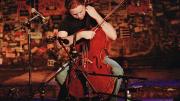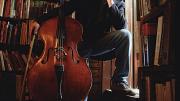Everyone in the recording booth agreed the cello wasn’t coming through. Matt Haimovitz ’96 huddled over the sound controls with his wife, producer Luna Pearl Woolf ’95, and the music’s composer, David Sanford, to listen to the playback. Sanford suggested that Haimovitz raise his part an octave, just for a few measures, to help it cut through the deep thicket of piano accompaniment. Jazz and opera singers, Sanford pointed out, do it all the time. Haimovitz joked that the next 50 cellists who played the piece would think he was doing it wrong, but agreed to give it a try.
“That’s the danger of having the composer there!” Haimovitz explained after the four-day recording session ended. “He can start changing everything and you have to re-practice it.”
Growing up, Haimovitz rarely faced this danger. When he enrolled at Princeton at 17—after studying at Juilliard for years, performing at Carnegie Hall, and signing a long-term record deal with Deutsche Grammophon—he had yet to play a note by a living composer. All that changed when electric guitarist Steven Mackey, a professor of composition at Princeton, invited Haimovitz to join him for a little free-form improv. Haimovitz credits those sessions for changing his approach to music. “All of a sudden I’m trying to find sounds that work with electric guitar,” he recalls. “All of a sudden [I’m] doing things the wrong way to get the right sound.” He dropped out of Princeton to tour (transferring to Harvard three years later), but his experiences there redirected his career to an exploration of the outer limits of his instrument. (“Matt mastered so much of the traditional repertoire at such a young age,” David Sanford says, that now “he has an appetite and a curiosity and a fire for new stuff.”)
Cello and piano may seem a natural pairing, but Haimovitz has titled his new album Odd Couple. Because the piano belongs to the percussion family and the cello to the strings, he claims, their sound qualities, or timbres, don’t match. Pianos also have fixed tunings, whereas a cellist can slide or vibrate notes to produce a more expressive intonation. But the biggest problem is that the piano’s massive sound can easily overwhelm the cello. This wasn’t as much a challenge for Bach and Beethoven—earlier keyboard instruments were softer—but in the recording studio in Montreal (where Haimovitz teaches cello at McGill University), he and Woolf (herself a composer) had to tinker constantly with the sound controls to pick up the right balance.
All four pieces on Odd Couple are by contemporary composers and take different approaches to combining the two instruments. In Cantos for Slava, by Augusta Read Thomas, BF ’91, JF ’94, Haimovitz and his pianist, Geoffrey Burleson, both plucked their strings, Haimovitz on the cello and Burleson inside the piano. Achieving balance in Sanford’s 22 Part 1, which Haimovitz likened to a “rock ’n’ roll boxing ring,” required furious bowing on the cello and digital amplification. The Cello Sonata, op. 6, by Samuel Barber, D.Mus. ’59, and the Sonata for Cello and Piano, by Elliott Carter ’30, D.Mus. ’70, complete the disc; Haimovitz calls the Carter “one of the most successful works in the genre, in the richness of each individual part and how the two come together” after each instrument begins in “its own metric world.” The music on Odd Couple, he says, is “maximalist”—dense and energetic, as opposed to the current trend among composers toward more minimalist scores.
Sharing new music is as important to Haimovitz as recording it. While recording for Deutsche Grammophon, he felt disconnected from the people buying his albums. “My work was in the session, and then essentially I would turn my back,” he says. Running his own independent label, Oxingale (www.oxingale.com), and selling CDs at his concerts has changed that. He tours from Thursday to Sunday nearly every week, and took his album Anthem (a celebration of American composers that begins with a version of Jimi Hendrix’s “Star-Spangled Banner”) to all 50 states. “What keeps me going at this stage is communicating with audiences,” he says. “And the fact that—as many composers as I’ve already played, as many of these genres as I’ve infiltrated—I’m just continuously amazed by how little I know.”
Although he never lacked for critical praise during his youth, Haimovitz has also won honors for his more innovative work. The American Society of Composers, Authors, and Publishers gave him the Concert Music Award for “taking his brilliant and passionate performances to audiences wherever they assemble,” including the late, legendary New York City punk-rock club CBGB. When the American Music Center (a New York City organization founded by Aaron Copland, D.Mus. ’61, among others) honored him as a “Trailblazer,” Haimovitz took out his cello and played “Star-Spangled Banner” during his acceptance speech. “Freedom of speech and freedom of expression are responsible for the breadth and quality of music and art we make here in the U.S.,” he says. “Jimi Hendrix understood this better than most politicians of his time. He also had the talent to communicate this and connect with a generation. I was just trying to channel a little piece of that.”
In September, when Odd Couple came out (the octave change stayed in), the cellist and his pianist toured with a disc jockey to perform composer Tod Machover’s VinylCello concerto, in which electronic sounds and turntables accompany Haimovitz. His goal in placing Sanford and Machover next to each other on a program is to say, “Wow! It’s just as unusual for me to be playing with a D.J. as it is for me to be playing with piano.”







